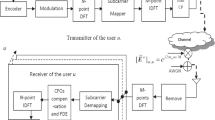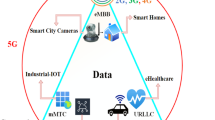Abstract
The paper investigates chirp pulse compression as a signal dimension reduction technique in non-coherent impulse-radio ultra-wideband (IR-UWB) communications. Two common types of non-coherent IR-UWB detection are considered, energy detection of IR-UWB pulse position modulated (PPM) symbols and sample-wise differential detection of differential phase shift keying (DPSK) IR-UWB symbols, as well as a newly introduced sample-wise differential detection of IR-UWB PPM symbols. A common problem with these low-complexity IR-UWB detection schemes is poor performance when the dimension of the symbol in detection is high, which is usually the case at low data rates and is especially pronounced in interference environments. Chirp pulse compression mitigates this problem by reducing the dimension of the symbol in detection along with very small fading factor, which also lowers the computational complexity in the case of digital implementation. In the analytic part of the paper, we develop a closed-form expression for the bandwidth and dimension of the signal after the chirp pulse compression, which was lacking before. Furthermore, a closed-form expression of the bit error probability in white noise with the above detection schemes is also given. In the numerical part of the paper, we compare the performance with and without chirp pulse compression of the above modulation/detection pairs in noise and interference environments.





Similar content being viewed by others
Notes
Since delay values equal to typical symbol times in IR-UWB are relatively hard to implement in the analog domain with current technology, practical implementations of DPSK symbol differentiation are expected to be digital.
References
Dotlić, I., & Kohno, R. (2010). Performance analysis of Impulse Radio Ultra-Wideband differential detection schemes for Body Area Networks. In: IEEE 21st International Symposium on Personal, Indoor and Mobile Radio Communications Workshops (PIMRC Workshops), pp. 72–77. doi:10.1109/PIMRCW.2010.5670515.
Dotlić, I., & Kohno, R. (2011). Low complexity chirp pulsed ultra-wideband system with near-optimum multipath performance. IEEE Transactions on Wireless Communications, 10(1), 208–218. doi:10.1109/TWC.2010.111910.100246.
Dotlić, I., & Kohno, R. (2011). Preamble Structure and Synchronization for IEEE 802.15.6 Impulse-Radio Ultra-Wideband Physical Layer. In: 5th International Symposium on Medical Information and Communication Technology, ISMICT.
Dotlić, I., & Miura, R. (2012). Chirp pulse compression in non-coherent impulse-radio ultra-wideband detection without waveform signature estimation. In: 15th International Symposium on Wireless Personal Multimedia Communications (WPMC), (pp. 113–117).
Gerrits, J. F. M., Kouwenhoven, M. H. L., van der Meer, P. R., Farserotu, J. R., & Long, J. R. (2005). Principles and limitations of ultra-wideband FM communications systems. EURASIP Journal of. Applied Signal Process, 2005(1), 382–396.
Lewis, D. (2012). IEEE P802.15.6-2012 Standard for Body Area Network. IEEE 802.15 WPAN.
McInnis, M. (2012). IEEE Standard for Local and Metropolitan area networks Part 15.4: Low-Rate Wireless Personal Area Networks (WPANs), Amendment: Active Radio Frequency Identification. IEEE 802.15 WPAN.
Molisch, A., Cassioli, D., Chong, C. C., Emami, S., Fort, A., Kannan, B., et al. (2006). A comprehensive standardized model for ultrawideband propagation channels. IEEE Transactions on Antennas and Propagation, 54(11), 3151–3166. doi:10.1109/TAP.2006.883983.
Proakis, J. (1968). On the Probability of Error for Multichannel Reception of Binary Signals. IEEE Transactions on Communication Technology, 16(1), 68–71. doi:10.1109/TCOM.1968.1089816.
Shannon, C. (1984). Communication in the presence of noise. Proceedings of the IEEE, 72(9), 1192–1201.
Simon, M. K., & Alouini, M. S. (2000). Digital Communication over Fading Channels: A Unified Approach to Performance Analysis. New York: Wiley.
Witrisal, K., Leus, G., Janssen, G., Pausini, M., Troesch, F., Zasowski, T., et al. (2009). Noncoherent ultra-wideband systems. IEEE Signal Processing Magazine, 26(4), 48–66. doi:10.1109/MSP.2009.932617.
Author information
Authors and Affiliations
Corresponding author
Rights and permissions
About this article
Cite this article
Dotlic, I., Miura, R. Chirp Pulse Compression in Non-Coherent Impulse-Radio Ultra-Wideband Communications. Wireless Pers Commun 74, 1297–1310 (2014). https://doi.org/10.1007/s11277-013-1578-x
Published:
Issue Date:
DOI: https://doi.org/10.1007/s11277-013-1578-x




